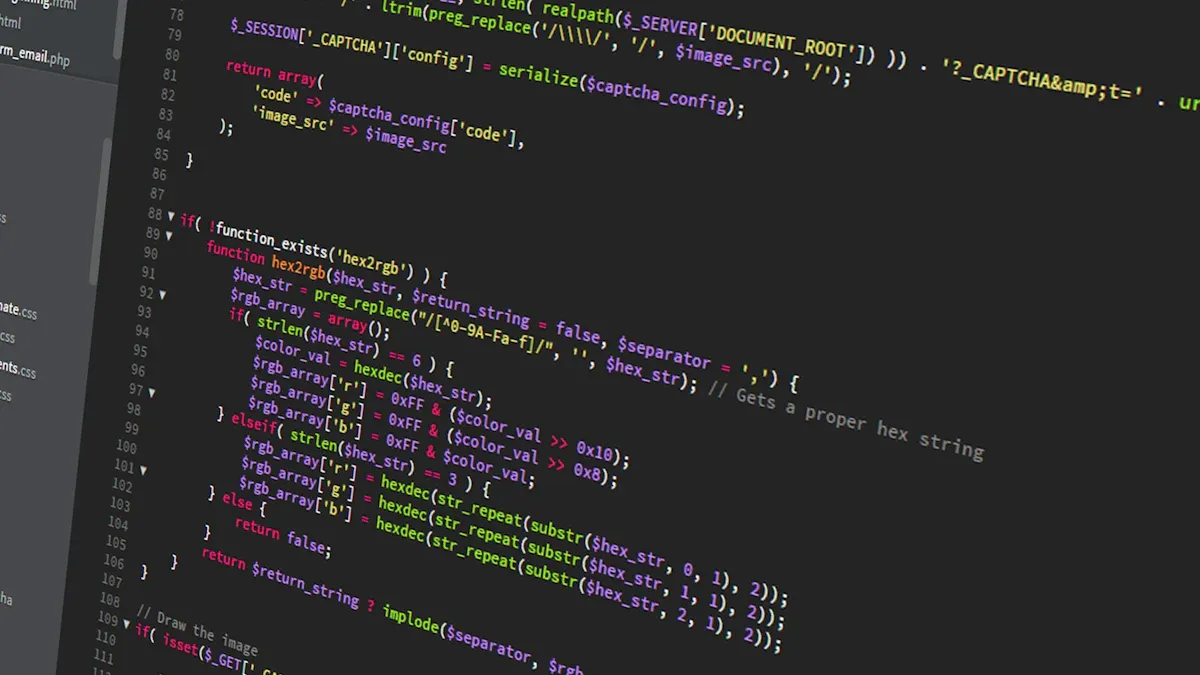What Sets MySQL Date Formatting Apart from Other SQL Databases in 2025

MySQL stands out in 2025 for its approach to date formatting, offering unmatched flexibility with the mysql date format function. MySQL uses DATE_FORMAT to customize date and time output, supporting extensive specifiers like %Y for year or %M for month name. Unlike other sql databases, MySQL enables direct filtering and comparison within formatted dates. The table below highlights key differences in date data types across major sql platforms:
Database | Date Data Types and Characteristics |
|---|---|
MySQL | DATE ('YYYY-MM-DD'), TIME ('hh:mm:ss'), DATETIME (date + time), TIMESTAMP (auto UTC conversion) |
PostgreSQL | DATE ('YYYY-MM-DD'), TIME (with optional timezone), TIMESTAMP (with optional timezone), INTERVAL |
SQL Server | DATE ('YYYY-MM-DD'), TIME ('hh:mm:ss'), SMALLDATETIME, DATETIME, DATETIME2, DATETIMEOFFSET |
Oracle | DATE (with optional time), TIMESTAMP (fractional seconds), TIMESTAMP WITH TIME ZONE |
Key Takeaways
MySQL uses native date types like DATE, DATETIME, and TIMESTAMP with flexible formatting through the DATE_FORMAT() function, allowing easy customization of date displays.
Always store dates using native types and the ISO 8601 format (YYYY-MM-DD) to ensure data accuracy, compatibility, and efficient comparisons.
MySQL supports direct date comparisons with standard operators, making queries simple and fast without needing string conversions.
Recent 2025 updates encourage handling date formatting in application code rather than relying on database features like ZEROFILL or YEAR(2), improving clarity and reducing errors.
When working across databases, understand MySQL’s strengths in simplicity and performance, but consider other systems like PostgreSQL or Oracle for advanced date operations or strict error handling.
MySQL Date Format Features
Core Functions
MySQL provides robust support for handling date and time values, making it a preferred choice for many sql applications. The database stores date values using native types such as DATE, DATETIME, and TIMESTAMP. Each type serves a specific purpose:
DATE: Stores only the date in the format 'YYYY-MM-DD'.
DATETIME: Stores both date and time as 'YYYY-MM-DD hh:mm:ss[.fraction]'.
TIMESTAMP: Similar to DATETIME, but automatically converts values to UTC and back based on the session timezone.
The default display formats for these types ensure consistency and compatibility across sql systems. The table below summarizes the key characteristics:
Data Type | Default Display Format | Supported Range | Fractional Seconds Precision (fsp) | Notes on Compatibility and Usage |
|---|---|---|---|---|
DATE | 'YYYY-MM-DD' | '1000-01-01' to '9999-12-31' | N/A | No fractional seconds. Values can be assigned as strings or numbers. |
DATETIME | 'YYYY-MM-DD hh:mm:ss[.fraction]' | '1000-01-01 00:00:00.000000' to '9999-12-31 23:59:59.999999' | Default 0 (no fractional part), range 0 to 6 | Default fractional seconds precision is 0, which differs from the sql standard default of 6. Supports automatic initialization and updating. |
MySQL offers a comprehensive set of functions for date formatting and manipulation. The mysql date format function, DATE_FORMAT(), stands out for its flexibility. It allows users to customize the output of date and time values using a wide range of specifiers. Here are some of the most commonly used specifiers:
Specifier | Description |
|---|---|
%Y | Year, four digits |
%y | Year, two digits |
%m | Numeric month (00..12) |
%M | Month name (January..December) |
%d | Numeric day of the month (00..31) |
%D | Day of the month with English suffix (1st, 2nd, 3rd, etc.) |
%H | Hour (00..23) |
%i | Minutes (00..59) |
%S | Seconds (00..59) |
%W | Weekday name (Sunday..Saturday) |
Other essential functions include YEAR(), MONTH(), DAY(), NOW(), CURDATE(), and DATE_SUB(). These functions enable users to extract specific parts of a date, perform date arithmetic, and obtain the current date or time.
MySQL supports direct date comparison using native types and standard operators such as =, <, >, and BETWEEN. This approach ensures efficient and accurate comparisons without the need for string conversions. However, using functions like DATE() on columns can impact index usage and performance, so careful query design is important.
Tip: Always use native date types for storage and comparison. Avoid storing dates as strings to maintain data integrity and performance.
Syntax Overview
The syntax for formatting dates in MySQL is both intuitive and powerful. The DATE_FORMAT() function takes a date value and a format string containing specifiers prefixed by '%'. This design allows users to present dates in any style required by their application or reporting needs.
SELECT DATE_FORMAT(order_date, '%Y-%m-%d %H:%i:%S') AS formatted_date
FROM orders;
This query returns the order_date in the format 'YYYY-MM-DD HH:MM:SS', which is easy to read and process. MySQL's approach to date formatting differs from other sql databases. For example, PostgreSQL uses TO_CHAR(), SQL Server uses FORMAT(), and SQLite uses strftime(). Each system has its own syntax and formatting rules, making the mysql date format function unique.
Common use cases for DATE_FORMAT() include:
Generating reports with dates in specific formats.
Displaying dates in query results in a readable style.
MySQL also provides STR_TO_DATE() for parsing strings into date values, and TIME_FORMAT() for formatting time values. These functions, combined with the extensive list of specifiers, give developers fine-grained control over how dates appear in their sql queries.
2025 Updates
In 2025, MySQL introduced several changes that impact date formatting and storage. The removal of the ZEROFILL attribute means that numeric fields, including those related to date and time, no longer receive automatic padding with leading zeros. Developers now handle padding outside the database, often in application logic.
MySQL also deprecated the TIMESTAMP(N) display width. Fractional seconds precision is now managed differently, and specifying display width no longer affects formatting. The YEAR(2) data type was removed due to risks of data corruption and formatting issues. Users should now rely on the standard YEAR(4) or DATE types for storing year values.
These updates reflect a broader shift in best practices. MySQL encourages handling date and time formatting in application logic rather than relying on schema-level features. This approach improves clarity and reduces the risk of errors.
Note: Always use ISO 8601 format (YYYY-MM-DD) for storing dates. This practice ensures compatibility across sql databases and prevents confusion in international or multi-system environments.
Best Practices to Compare SQL Dates
Use appropriate data types such as DATE, DATETIME, or TIMESTAMP instead of strings.
Store timestamps in UTC when working across multiple time zones.
Avoid regional date formats; consistently use ISO 8601.
Validate date inputs to prevent invalid or ambiguous values.
Use direct comparison operators for efficient date comparison.
SELECT event_name
FROM events
WHERE event_start > NOW();
This query demonstrates a best practices to compare sql dates, using native types and direct comparison for accuracy and performance.
MySQL's approach to date formatting and comparison in 2025 emphasizes flexibility, precision, and compatibility. By following these guidelines, developers can ensure reliable and efficient handling of dates in any sql database environment.
Compare Dates Across Databases

MySQL vs. PostgreSQL
When developers compare dates in MySQL and PostgreSQL, they notice both similarities and important differences. Both systems use the YYYY-MM-DD format for dates and HH:MM:SS for time by default. However, PostgreSQL offers more advanced date and time handling. It supports native time zones and interval arithmetic, which allows for complex operations. MySQL relies on specific functions for most date operations, while PostgreSQL uses explicit interval syntax and arithmetic operators.
For example, to compare sql dates in MySQL, a user might write:
SELECT * FROM orders WHERE order_date > '2025-01-01';
In PostgreSQL, the syntax is similar, but the database provides additional functions such as AGE() and EXTRACT() for more precise date calculations. PostgreSQL also supports richer SQL compliance, making it more flexible for complex date operations. MySQL’s syntax remains simpler, which benefits users who need straightforward date sql compare syntax.
Note: PostgreSQL’s broader range of data types and advanced SQL compliance make it a strong choice for applications requiring complex date logic, while MySQL excels in simplicity and ease of use for basic date comparisons.
MySQL vs. SQL Server
Comparing sql dates between MySQL and SQL Server reveals distinct differences in function names and syntax. SQL Server uses FORMAT() and CONVERT() for date formatting, while MySQL uses DATE_FORMAT() and STR_TO_DATE(). The following table highlights these differences:
Aspect | SQL Server | MySQL |
|---|---|---|
Primary formatting functions | FORMAT(), CONVERT() | DATE_FORMAT(), STR_TO_DATE() |
Syntax example |
|
|
Locale handling | FORMAT supports locale specifier inline (e.g., 'en-us') | Uses format specifiers in functions; locale is implicit in format strings |
Performance | FORMAT is convenient but has significant overhead (up to ~200ms runtime) | Generally efficient; no noted significant overhead in formatting functions |
Handling string to date conversion | Uses CONVERT with style codes (e.g., 103 for British/French format) | Uses STR_TO_DATE with format specifiers (e.g., '%d/%m/%Y %H:%i:%s') |
Additional notes | FORMAT aligns with other programming languages (e.g., C#) but not supported in all SQL Server variants (e.g., Azure SQL Edge) | Uses format specifiers similar to C-style formatting; no direct equivalent to FORMAT function |
When users compare sql dates in SQL Server, they often use CONVERT or FORMAT, which can introduce performance overhead. MySQL’s approach is generally more efficient, especially for large datasets. Both systems allow direct date comparisons, but their function names and syntax differ significantly.
MySQL vs. Oracle
Oracle and MySQL handle date formatting and comparison with unique behaviors. MySQL allows storing '0000-00-00' as a dummy date unless the NO_ZERO_DATE SQL mode is enabled. Oracle does not permit this and raises errors for invalid dates. MySQL interprets two-digit years in a specific way, converting 00-69 to 2000-2069 and 70-99 to 1970-1999, which can cause ambiguity. Oracle avoids this by requiring explicit year formats.
MySQL requires strict year-month-day input order for dates, while Oracle’s TO_DATE function accepts flexible format strings.
MySQL automatically converts date/time values to numbers in numeric contexts, but Oracle does not.
Out-of-range or illegal date/time values in MySQL become zero values, while Oracle raises errors.
MySQL uses functions like ADDDATE() with INTERVAL, while Oracle uses DATEADD() or INTERVAL with different syntax.
Oracle uses SYSDATE without parentheses and requires selecting from DUAL, while MySQL uses SYSDATE().
Oracle supports EXTRACT() for date parts, while MySQL uses YEAR(), MONTH(), and similar functions.
These differences affect how developers compare sql dates and migrate data between the two systems. Oracle’s stricter error handling and flexible input formats provide more control, while MySQL’s behaviors can lead to unexpected results if not managed carefully.
MySQL vs. SQLite
SQLite and MySQL take different approaches to date storage and formatting. SQLite stores timestamps with fractional seconds precision, such as '2011-04-14 22:52:52.758612'. MySQL typically rounds timestamps to the nearest second, like '2011-04-14 22:52:52'. This difference can impact how users compare dates, especially when high precision is required.
SQLite does not have dedicated datetime storage types. It stores dates as text strings in ISO 8601 format, allowing date comparisons using lexicographical string comparison. This works as long as the formats remain consistent. MySQL, on the other hand, uses specific date/time types and functions, which handle date comparisons differently and more efficiently.
Formatting functions also differ. MySQL uses '%s.%f' for seconds and fractional seconds, while SQLite uses '%f' alone for fractional seconds. This subtle difference can cause confusion when migrating queries or data between the two systems.
Tip: When migrating date data between MySQL and SQLite, always check for differences in precision and format specifiers to avoid unexpected results in date sql compare syntax.
Compare Two Dates in MySQL
Operators and Functions
Developers often need to compare two dates in MySQL to filter records, calculate intervals, or validate data. MySQL stores dates in the YYYY-MM-DD format, which allows for straightforward sql operations. The platform provides several operators and functions for date comparison:
=,<,>,<=,>=,<>, and!=let users compare two dates directly in sql queries.The
BETWEENandNOT BETWEENoperators help filter records within or outside a specific date range.The
<=>operator performs NULL-safe equality comparison, which is useful when one or both dates might be NULL.The
DATE_ADD()function adds or subtracts intervals from a date, making it easier to compare two dates after manipulation.The
NOW()function returns the current date and time, often used to compare sql dates against the present moment.The
DATE()function extracts the date part from a DATETIME or TIMESTAMP, ensuring accurate comparison when time components are present.
For example, to compare two dates in sql and find orders placed after a certain date, a developer might use:
SELECT * FROM orders WHERE order_date > '2025-01-01';
These operators and functions enable flexible and precise date comparison in MySQL, supporting a wide range of sql use cases.
Best Practices
Effective date comparison in MySQL requires attention to data types, formatting, and performance. The following best practices help developers compare two dates accurately and efficiently:
Use native DATE or DATETIME types for all date columns. Avoid storing dates as strings to prevent errors and ensure efficient sql queries.
Always use the ISO format (YYYY-MM-DD) for consistency in sql operations.
Normalize time zones with the
CONVERT_TZfunction when comparing dates across regions.Index date columns to speed up sql queries, especially when working with large datasets.
Avoid applying functions directly to indexed date columns in WHERE clauses. This practice ensures that MySQL can use indexes for faster comparison.
Use range queries like
BETWEENfor efficient filtering when you need to compare two dates within a range.Handle NULL values explicitly with
IS NULLorIS NOT NULLto avoid unexpected results in sql comparison.Use prepared statements in dynamic sql queries to prevent injection and maintain correct date formatting.
When comparing DATETIME with DATE, use the
DATE()function to strip the time part if necessary.Consider partitioning large tables by date to improve sql query performance.
Tip: Always create indexes on date columns and use direct range comparisons to leverage MySQL's indexing capabilities. Avoid comparing dates with non-standard string formats to prevent errors.
By following these best practices, developers can compare two dates in MySQL with confidence, ensuring both accuracy and performance in their sql applications.
MySQL Strengths and Limitations
Unique Advantages
MySQL stands out in the sql world for its straightforward approach to handling dates. The database offers native types like DATE, DATETIME, and TIMESTAMP, which allow developers to store and compare dates efficiently. MySQL’s DATE_FORMAT function provides a flexible way to display dates in any style required by an application. This function supports a wide range of specifiers, making it easy to customize date output for reports or user interfaces. MySQL enables direct comparison of dates using standard sql operators, which simplifies query writing and improves performance. The database also supports date arithmetic, allowing users to add or subtract intervals from dates without complex logic. These features make MySQL a reliable choice for applications that require frequent date comparisons and formatting.
Common Drawbacks
Despite its strengths, MySQL has some limitations when working with dates in sql queries. Developers sometimes store dates as VARCHAR, which removes data validation and disables native date functions. This practice complicates sql queries and increases the risk of errors. MySQL drivers often return date and time values as strings, so developers must convert them to date objects in application code. Regional differences in date formats can cause confusion and make consistent formatting challenging. The DATETIME type in MySQL has a limited range, which may not suit applications needing long-term date storage. TIMESTAMP fields can update automatically if not declared carefully, leading to unexpected results. MySQL lacks millisecond precision in its native date types, forcing developers to use workarounds that add complexity to sql operations.
DATETIME fields have a limited range, typically up to the year 2038.
TIMESTAMP fields may update automatically on row changes.
Native types lack millisecond precision.
Regional variations in date formats complicate consistent handling.
Tip: Always use native date types in MySQL to maintain data integrity and simplify sql queries.
Real-World Scenarios
In real-world sql projects, teams often need to manage dates across multiple database systems. MySQL’s approach works well for most applications, but cross-database compatibility can become a challenge. Chat2DB addresses this issue by providing an intuitive interface for creating and managing sql queries involving dates. Users can generate complex date-related queries using natural language, even if they lack deep sql expertise. Chat2DB handles time zones and date arithmetic, streamlining workflows for teams working with multiple databases. The platform visualizes date data and generates comprehensive reports, making it easier to compare dates and manage formatting across different database systems. By leveraging Chat2DB, organizations can improve efficiency and accuracy in their sql operations involving dates.
Practical Examples with MySQL Date Format

Common Tasks
Developers frequently perform several essential tasks when working with dates in MySQL. These tasks help ensure data accuracy and improve the readability of sql query results.
Store dates using the correct data types, such as date for birthdays, datetime for event scheduling, and timestamp for logging events with time zone awareness.
Format dates for user-friendly display using the DATE_FORMAT function. For example,
SELECT DATE_FORMAT(order_date, '%W, %M %d, %Y') FROM orders;returns results like "Sunday, June 15, 2025".Extract components from a datetime or timestamp, such as year or month, to group or filter data. Queries like
SELECT YEAR(created_at), COUNT(*) FROM users GROUP BY YEAR(created_at);help generate annual reports.Calculate differences between two dates using DATEDIFF for days or TIMESTAMPDIFF for more precise intervals. This is useful for tracking durations or deadlines in sql.
Convert UNIX timestamps to readable formats with FROM_UNIXTIME, making it easier to interpret raw data.
Filter records by date ranges, such as retrieving recent orders with
SELECT * FROM sales WHERE order_date BETWEEN CURDATE() - INTERVAL 7 DAY AND CURDATE();.Automate future date calculations using DATE_ADD, such as determining the next payment due date.
Tip: Always choose the right data type for each use case. Use timestamp for logs, datetime for events, and date for simple calendar entries.
Advanced Formatting
Complex reporting and analytics often require advanced date formatting techniques in MySQL. These methods help users extract deeper insights from their data.
Technique/Concept | Description | Example Query or Note |
|---|---|---|
DATE_FORMAT Function | Converts dates into specific display formats for reports and dashboards. |
|
Week of the Year Extraction | Groups data by week for trend analysis. |
|
Date Comparisons | Filters records within specific date ranges using date arithmetic. |
|
Performance Considerations | Indexes date, datetime, and timestamp columns to speed up sql queries on large datasets. | Index columns used in WHERE, JOIN, or GROUP BY clauses for better performance. |
Best practices for advanced formatting include normalizing all timestamp and datetime values to a single time zone, documenting complex sql queries, and testing for edge cases like leap years. Avoid storing dates as strings to prevent errors and inefficiencies.
Using Chat2DB
Chat2DB streamlines sql workflows involving date, datetime, and timestamp fields. Users can generate complex queries using natural language, reducing the need for manual sql coding. For example, a user might ask, "Show all orders placed in the last 30 days," and Chat2DB will generate the correct sql using date ranges and the appropriate datetime or timestamp functions.
Chat2DB also visualizes date-based data, making it easier to spot trends over time. The platform supports multi-database environments, so users can manage sql queries involving date, datetime, and timestamp fields across MySQL, PostgreSQL, and other systems without switching tools. With AI-driven suggestions, Chat2DB helps users select the right functions for formatting, filtering, and comparing dates, ensuring accuracy and consistency in every sql operation.
Best Use Cases for MySQL
Ideal Scenarios
MySQL excels in projects that demand reliable date and time management. Teams often select MySQL for historical data management systems. These systems require exact preservation of entered dates to maintain data integrity. Event scheduling applications also benefit from MySQL, as they need date and time consistency across different time zones. Audit trail systems rely on MySQL to log creation and modification times with precise timezone accuracy. Real-time data applications, such as chat logs or analytics platforms, depend on MySQL for accurate timestamping and robust timezone handling.
Other ideal scenarios include:
Data analytics and machine learning projects that require detailed slicing and dicing of date and time data.
Pricing models where date and time manipulation is critical for business decisions.
Applications that need operations like adding or subtracting dates, finding differences between dates, and extracting specific parts of date or time values.
MySQL's native support for date and time types, combined with its flexible formatting functions, makes it a strong choice for these use cases. Developers can write efficient sql queries to filter, group, and analyze date-based data with ease.
When to Choose Another Database
Some projects may require features beyond what MySQL offers. Applications that need advanced interval arithmetic or more complex time zone management might benefit from PostgreSQL. Oracle provides strict error handling and flexible input formats, which suit enterprise environments with rigorous data requirements. SQL Server offers integration with Microsoft tools and supports unique formatting functions. SQLite works well for lightweight, embedded applications where storage simplicity matters more than advanced sql features.
Note: Teams should evaluate the specific requirements of their project before selecting a database. Consider the complexity of date operations, the need for cross-database compatibility, and the scale of data processing.
MySQL distinguishes itself in 2025 with its flexible DATE_FORMAT() function and intuitive syntax, enabling developers to tailor date output for any application. Adopting the ISO 8601 format (YYYY-MM-DD) ensures clarity and consistency across systems. The table below highlights standard date types and formats:
Data Type | Format Example |
|---|---|
DATE | 'YYYY-MM-DD' |
DATETIME | 'YYYY-MM-DD HH:MM:SS' |
TIMESTAMP | 'YYYY-MM-DD HH:MM:SS' (UTC) |
Database administrators should always validate date inputs, display the correct time zone, and use engine-specific SQL functions for formatting. Choosing MySQL benefits teams seeking simplicity, reliability, and global compatibility in date handling.
FAQ
How does MySQL handle time zones in date formatting?
MySQL stores TIMESTAMP values in UTC and converts them to the session’s time zone for display. Developers should set the correct time zone for accurate results. Using CONVERT_TZ() helps manage time zone conversions in queries.
Can MySQL format dates for different locales?
MySQL’s DATE_FORMAT() function uses format specifiers, not locale settings. To display dates in different languages or formats, developers must handle localization in the application layer or use custom queries.
What is the best way to compare two dates in MySQL?
Use native date types and direct comparison operators like =, <, or BETWEEN. Avoid comparing dates stored as strings. Index date columns for faster queries.
Does MySQL support fractional seconds in DATETIME and TIMESTAMP?
Yes. MySQL supports fractional seconds with DATETIME and TIMESTAMP types. Specify precision using fsp (e.g., DATETIME(3)). This feature allows millisecond-level accuracy.
How can Chat2DB help with MySQL date formatting?
Chat2DB generates SQL queries for date formatting using natural language. Users can manage, visualize, and compare date fields across multiple databases without writing complex SQL manually.
See Also
Essential Database Clients To Explore In The Year 2024
A Comprehensive Comparison Of Top Database Systems For 2025
Leading SQL Client Applications Available On Windows In 2024
Ten Essential Text-To-SQL Tools You Should Try In 2024
Ten Helpful Tips To Improve SQL Code Formatting And Maintenance

